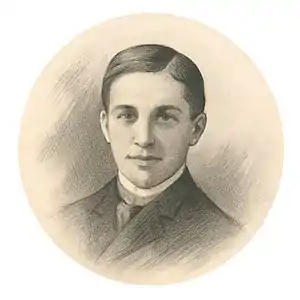Ernest Thayer
Ernest Lawrence Thayer (/ˈθeɪər/; August 14, 1863 – August 21, 1940) was an American writer and poet who wrote the poem "Casey" (or "Casey at the Bat"), which is "the single most famous baseball poem ever written" according to the Baseball Almanac,[1] and "the nation’s best-known piece of comic verse—a ballad that began a native legend as colorful and permanent as that of Johnny Appleseed or Paul Bunyan."[2]
Ernest Thayer | |
|---|---|
 | |
| Born | August 14, 1863 Lawrence, Massachusetts |
| Died | August 21, 1940 (aged 77) Santa Barbara, California |
| Pen name | Phin |
| Occupation | Poet |
| Nationality | American |
| Spouse | Rosalind Buel Hammett |
| Partner | Rose Washington |
| Children | Jillian Thayer |
Biography
Thayer was born in Lawrence, Massachusetts, and raised in nearby Worcester. He graduated magna cum laude in philosophy from Harvard University in 1885, where he had been editor of the Harvard Lampoon and a member of the theatrical society Hasty Pudding. William Randolph Hearst, a friend from both activities, hired Thayer as humor columnist for The San Francisco Examiner 1886–88.[2]
Ernest Thayer
Thayer's last piece, dated June 3, 1888, was a ballad entitled "Casey" ("Casey at the Bat") which made him "a prize specimen of the one-poem poet" according to American Heritage.[2]
It was not until several months after the publication of the poem that Thayer became famous for it, since he was hardly the boastful type and had signed the June 24 poem with the nickname "Phin" which he had used since his time as a writer for the Harvard Lampoon.[1] Two mysteries remain about the poem: whether Casey and Mudville were based on a real person or place, and, if so, their actual identities. On March 31, 2007, Katie Zezima of The New York Times wrote an article called "In 'Casey' Rhubarb, 2 Cities Cry 'Foul!'" on the competing claims of two towns to such renown: Stockton, California, and Holliston, Massachusetts.[3] On the possible model for Casey, Thayer dismissed the notion that any single living baseball player was an influence. However, late 1880s Boston star Mike "King" Kelly is likely as a model for Casey's baseball situations. Besides being a native of a town close to Boston, Thayer, as a San Francisco Examiner baseball reporter in the off-season of 1887–88, covered exhibition games featuring Kelly. During November 1887, some of his reportage about a Kelly at-bat has the same ring as Casey's famous at-bat in the poem. A 2004 book by Howard W. Rosenberg, Cap Anson 2: The Theatrical and Kingly Mike Kelly: U.S. Team Sport's First Media Sensation and Baseball's Original Casey at the Bat, reprints a 1905 Thayer letter to a Baltimore scribe who was asking about the poem's roots. In the letter, Thayer named Kelly (d. 1894), as having shown "impudence" in claiming to have inspired it. Rosenberg argues that if Thayer still felt offended, Thayer may have later denied Kelly as an influence. Kelly had also performed as a vaudeville actor, and recited the poem dozens of times.

The first public performance of the poem was on August 14, 1888, by actor De Wolf Hopper, on Thayer's 25th birthday. Thayer's recitation of the poem at a Harvard class reunion in 1895 helps solve the mystery, which lingered into the 20th century, of who had written it.
During the mid-1890s, Thayer contributed several other comic poems for Hearst's newspaper New York Journal and then began overseeing his family's mills in Worcester full-time. Thayer relocated to Santa Barbara in 1912, where he married Rosalind Buel Hammett and retired. He died in 1940, seven days after his 77th birthday.
The New York Times' obituary of Thayer on August 22, 1940, p. 19 quotes comedian DeWolf Hopper, who helped make the poem famous:
Thayer indubitably wrote "Casey," but he could not recite it.... I have heard many others give "Casey." Fond mamas have brought their sons to me to hear their childish voices lisp the poem, but Thayer's was the worst of all. In a sweet, dulcet Harvard whisper he implored "Casey" to murder the umpire, and gave this cry of mass animal rage all the emphasis of a caterpillar wearing rubbers crawling on a velvet carpet. He was rotten.
References
- "Casey at the Bat by Ernest Thayer". Baseball Almanac. Retrieved October 17, 2012.
- Gardner, Martin (October 1967). "Casey at the Bat". American Heritage. 18 (6). Retrieved October 20, 2012.
- Zezima, Katie (March 31, 2004). "In 'Casey' Rhubarb, 2 Cities Cry 'Foul!'". The New York Times. Retrieved June 3, 2008.
| Wikisource has original works written by or about: Ernest Thayer |
| Wikiquote has quotations related to: Ernest Thayer |
External links
- Works by Ernest Thayer at LibriVox (public domain audiobooks)

- Ernest Lawrence Thayer at Find a Grave
- Ernest Lawrence Thayer: Profile and Poem at Poets.org